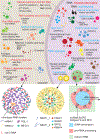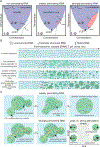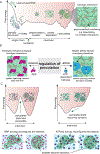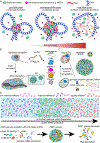RNA-driven phase transitions in biomolecular condensates
- PMID: 39366355
- PMCID: PMC11604179
- DOI: 10.1016/j.molcel.2024.09.005
RNA-driven phase transitions in biomolecular condensates
Abstract
RNAs and RNA-binding proteins can undergo spontaneous or active condensation into phase-separated liquid-like droplets. These condensates are cellular hubs for various physiological processes, and their dysregulation leads to diseases. Although RNAs are core components of many cellular condensates, the underlying molecular determinants for the formation, regulation, and function of ribonucleoprotein condensates have largely been studied from a protein-centric perspective. Here, we highlight recent developments in ribonucleoprotein condensate biology with a particular emphasis on RNA-driven phase transitions. We also present emerging future directions that might shed light on the role of RNA condensates in spatiotemporal regulation of cellular processes and inspire bioengineering of RNA-based therapeutics.
Keywords: RNA chaperones; RNP granules; gene regulation; helicases; liquid-liquid phase separation; percolation; stress granules.
Copyright © 2024 Elsevier Inc. All rights reserved.
Conflict of interest statement
Declaration of interests P.R.B. is a member of the Biophysics Reviews (AIP Publishing) editorial board. This affiliation did not influence the work reported here.
Figures





References
-
- Ladouceur A-M, Parmar BS, Biedzinski S, Wall J, Tope SG, Cohn D, Kim A, Soubry N, Reyes-Lamothe R, and Weber SC (2020). Clusters of bacterial RNA polymerase are biomolecular condensates that assemble through liquid–liquid phase separation. 117, 18540–18549. 10.1073/pnas.2005019117 %J Proceedings of the National Academy of Sciences. - DOI - PMC - PubMed
-
- Cubuk J, Alston JJ, Incicco JJ, Singh S, Stuchell-Brereton MD, Ward MD, Zimmerman MI, Vithani N, Griffith D, Wagoner JA, et al. (2021). The SARS-CoV-2 nucleocapsid protein is dynamic, disordered, and phase separates with RNA. Nature Communications 12, 1936. 10.1038/s41467-021-21953-3. - DOI - PMC - PubMed
Publication types
MeSH terms
Substances
Grants and funding
LinkOut - more resources
Full Text Sources

